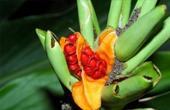Aronic Spotted

Toxic! It is guarded. Aroids - Agaseae.
Used parts
Rhizome, sometimes leaves. Pharmacy name: Aronia rhizome - Arirhizoma( formerly: Rhizoma Ari);Aronian leaves are Ari folium( formerly: Folia Ari).
Botanical description
The arnon is fixed in the soil with the help of a round-ovoid rhizome, from which numerous thin and thick accessory roots leave. The rosette of the basal leaves with an arrow-shaped form with long petioles at the base is surrounded by brownish scaly leaves. But the brightest sign of this plant is a long inflorescence with a leaf-like wrapper. Flowers are same sex. They sit tightly on a violet-brown, above cone-shaped thickened peduncle, forming an inflorescence-cob. Female flowers are at the bottom, then there is a ring of hairs, and above are the male flowers. The inflorescence thus arranged is a trap for small insects attracted by the evening fragrance of the cob. After falling into the "trap", insects are forced to pollinate the flowers. In the polluted flower, the hairs subside, and the insects can escape to the outside. Soon after fertilization, the apex of the ear and the leaf of the wrapping die and develops an outflow of red berries. Blooms in April-May( until June).It occurs on lime-rich clay soils of wet floodplain forests, as well as in mixed forests and shrub thickets. Caution! All parts of the plant and bright red berries are very poisonous!
Active ingredients
The composition is poorly understood. Sharp volatile substances( aroene, aronine and aronidine), apparently, determine the toxicity of the plant. It should also be noted a large number of crystals of oxalic acid and its salts( oxalates), especially in leaves. Thin, sharp needles of calcium oxalate crystals touch the skin and mucous membranes when touched.
Homeopathy use
The homeopathic remedy Arum is still very popular with the common cold, inflammation of the oral mucosa, catarrh of the upper respiratory tract, in mumps, scarlet fever and measles. Arum helps in almost all cases of hoarseness, when the vocal cords are strained, for example, when a singer or speaker can not sing loudly or speak loudly. Take it in the dilution of D1-D6 several times a day for 3-5-8( up to 10) drops. You can also gargle with a strongly diluted tincture: 5 drops on a glass of warm water.
Side effects of
As all parts of the plant are very poisonous, any self-medication will be criminal levity. Signs of poisoning: a strong local irritation in the mouth and throat, then in the stomach and intestines. After absorption in the blood, general excitement first begins, and salivation, vomiting, loss of voice, convulsions, individual manifestations of paralysis and disruption of the heart function start later. Quite soon the appearance of unpleasant sensations in the mouth allows you to quickly respond to poisoning: you must immediately take a few tablets of activated charcoal, which will bind the poisonous substances. One of the measures of first aid may be the appointment of a mucous broth. In any case, you should consult a doctor to get professional help - especially against inflammation of the oral mucosa.
